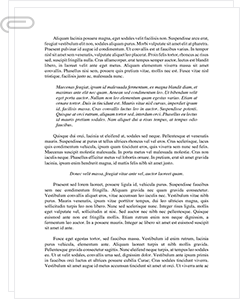 Study Document
Study Document
Family Legacy in the Piano Term Paper
Pages:2 (706 words)
Sources:1
Subject:Other
Topic:Family History
Document Type:Term Paper
Document:#85120993
Boy Willie's father, Boy Charles, set out to steal the piano with pictures of his family carved by his father, to return it to the rightful owners. As far as Boy Charles was concerned, the piano "was the story of [their] whole family and as long as Sutter had it . . . he had [them]," (Wilson, 1990, p. 45). Similarly, Boy Willie wishes to sell the family piano in order to receive something far more valuable to him -- Sutter's land -- in a move which would symbolically avenge the slavery his family endured under Sutter in the past. Boy Willie's impetuousness to this end and defiance of anyone to stand in his way, along with his fierce ambition to avenge his family's traumatic past allows him to carry on a legacy begun by his father.
Even if Berniece and Boy Willie were not so adamant about manifesting the influence of their parents, the presence of ghosts throughout the story would refuse the family history to fade. The greatest spiritual presence felt in the play is that of Sutter's ghost, who haunts the Charles' house as a constant reminder of his influence, his control over them, in life. The Ghosts of the Yellow Dog are mentioned periodically, but are most notable for their role in eliminating Sutter's living presence from the Charles' family when they are credited with pushing Sutter into his own well, leading to his death (Wilson, 1990, p. 5). These two specters have the most physical manifestations in the play, but there are also constant mentions of Mama Ola and Cleotha's spirits being not far off, even more reminders of the family's past and an enduring legacy not to be forgotten.
Throughout the play the characters reminisce about past history and the family legacy. The fight for the greatest family heirloom allows this legacy to be brought to life, and the similarities of the children to their parents and the seen and unseen presence of spirits connected to the family's past allow that legacy to endure throughout…
Sample Source(s) Used
References
Wilson, August. 1990. The Piano Lesson. New York: Penguin Group.
Related Documents
 Study Document
Study Document
Who Is the Protagonist of the Piano Lesson by August Wilson
Piano Lesson In August Wilson's play The Piano Lesson, Berniece is the protagonist or the heroine and main character, who represents the traditions and heritage of the family going back to the times of slavery and even to Africa itself. Willie on the other hand is the antagonist, a violent and angry man, a thief and a murderer who takes revenge on the Sutter family but now intends to use the
 Study Document
Study Document
Piano Lesson: Ambivalence and Legacy
But the piano is also inlaid with carvings made by her father's own hands. Bernice's ambivalence is also exemplified in the fact that Bernice refuses to sell the piano, yet she also refuses to play the instrument, for fear of waking the spirits within it. "I don't play that piano 'cause I don't want to wake them spirits" (70). Bernice's brother Willie scoffs "ain't no ghost," which demonstrates his often
 Study Document
Study Document
The Piano Lesson By August Wilson
Prompt 2: The Piano Lesson and the Blues
The blues is described as a uniquely African American musical tradition, combining folk music, traditional work songs once sun by slaves, jazz, and other musical traditions to describe both personal suffering and to create an oral history of all individuals who have sung it. In August Wilson’s 1986 play The Piano Lesson, an heirloom piano comes to embody the blues tradition for
 Study Document
Study Document
Piano, Including the History and Use of
piano, including the history and use of the instrument. The piano is one of the most popular musical instruments in the world, and pianos have been in use in orchestras and in homes for hundreds of years. The first piano was created from another similar instrument, the harpsichord, and it was invented in Italy. The editors at Wikipedia note, "The invention of the modern piano is credited to Bartolomeo
 Study Document
Study Document
Beethoven's Piano Sonata No. 31
In this movement he uses antiphonal, or equal bars of forte and equal bars of piano as the movement opens with a six note falling scale motif for this harmony. Finally there is a trio in D major, side by side, taking abrupt leaps and descents and which ends quietly with a modified recurrence of the scherzo. The first "repeat" was written out to allow an extra ritardando. There
 Study Document
Study Document
Raisin in the Sun Significance
At the same time Bernice doesn't tell her daughter the history of the heirloom, in fear of waking the spirit. This means that even Bernice is not using her legacy positively, but is afraid of it. Both characters are able to embrace their history with pride by the end of the play, as Boy Willie comes to understand the Piano's significance and Bernice begins to play it again (Sparknotes.com) 3.



